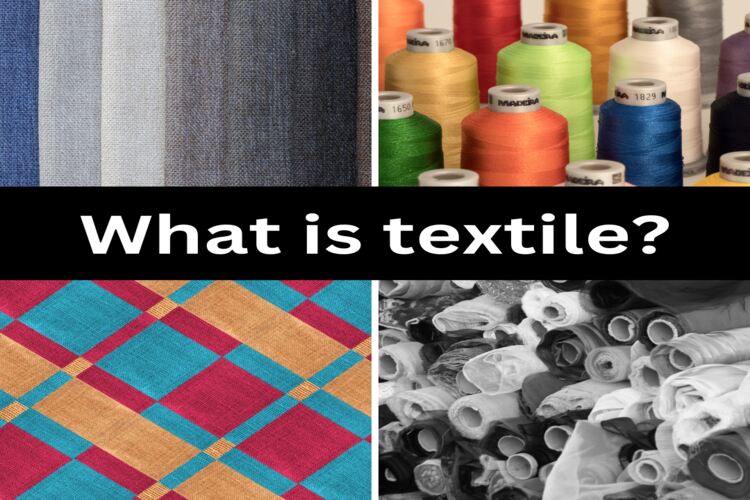What is textile?
Textiles are an integral part of our everyday existence, spanning across multiple facets of our lives. They encompass our clothing, furnishings, carpets, and bedding. These textiles can be constructed from either natural or synthetic fibers, and they are created using methods such as weaving, knitting, felting, or even printing.
Definition of Textile
The word ‘textile’ comes from Latin, specifically the term ‘textiles,’ which means ‘woven.’ This Latin word is derived from ‘textus,’ the past participle of the verb ‘texere,’ which means ‘to weave.’
A textile, also known as fabric or cloth, is a flexible material made from a network of natural or synthetic fibers (threads or yarn). These fibers are woven or knitted together or pressed into felt. Textiles include various items, such as clothing and footwear – essentially, anything wearable! Unfortunately, many functional clothing items end up discarded due to changing fashion trends, size differences, tears, or damage. Instead of simply throwing them in landfills, these textiles can be recycled, giving them a second chance.
Branches Of The Textiles Industry
- Fiber: Textile fiber comes mainly from natural or synthetic sources and is transformed into textile yarns and fabrics using processes such as weaving, knitting, nonwoven methods, and carpet manufacturing. It can take the form of a flexible, hair-like strand or serve as the smallest visible unit in textile production.
- Yarn: Yarn is produced by gathering fibers and either laying them together or twisting them to create a continuous strand. Yarns can be crafted using either staple fibers or filament fibers.
- Fabric: Fabric is created by weaving threads of various materials like cotton, nylon, wool, silk, and more. It’s the essential material for making things like clothing, curtains, and bed linens.
- Accessories: The materials utilized in textiles to enhance the visual appeal of a garment for marketing and packaging, in addition to the fabric and trims, are known as accessories.
- Dyeing, Printing, and Embroidery: Dyeing, printing, and embroidery are techniques used to turn raw textile fibers into finished products, making textile fabrics more visually appealing.
- Pre-Treatment: Pre-treatment is a series of steps aimed at removing impurities from fibers or fabric, and preparing them for dyeing or printing. Natural and synthetic fibers carry both natural primary impurities and secondary impurities added during the spinning, knitting, and weaving processes in textiles.
- Manufacturing: Garment production is a methodical process in textiles with several key steps. These steps include laying, marking, cutting, stitching, quality checking, finishing, pressing, and packaging. Ultimately, this process turns raw materials into finished products.
- Finishing treatment: Finishing includes various techniques that transform woven or knitted fabrics into a usable material. It involves processes carried out after dyeing the yarn or fabric, aiming to enhance the appearance, performance, or overall feel of the final textile product or clothing.
- Packing: Garment packaging includes wrapping, compressing, filling, or organizing goods to protect them and ensure they are handled properly. This is the final step in garment production, getting the finished products ready for delivery to the customer. It’s a crucial part of the garment manufacturing process and needs the customer’s close attention. After the entire manufacturing process is completed, the clothing is packed according to specific instructions. These packed garments are then put into cartons and stored in a designated area until they are prepared for delivery to the respective buyer.
- Shipment: In the textile industry, shipping involves the transportation of fabrics and finished garments and products. A common method for moving textiles across the country is by using freight trucks.
Use Of Textile
Textiles are highly significant in material culture, serving various roles as technological products, cultural symbols, artistic expressions, and trade commodities. The textile arts represent a fundamental human activity, symbolically conveying much of what holds value in any culture.
Textiles have been employed in numerous practical applications, taking advantage of their unique characteristics. Some examples of textile products include:
- Bags and items for carrying objects
- Balloons, kites, sails, and parachutes. In the early days of aviation, cloth was a crucial component in aircraft construction.
- Clothing
- Flags
- Furnishings and a variety of home accessories
- Geotextiles
- Industrial and scientific uses, such as filtration
- Nets
- Rugs and carpets Bio textile and medical science
You may also like:
- What is Linen Fiber? Properties, Structure, and How It Made?
- What is Jute Fiber? Properties, Advantages and Disadvantages.
- What is Hemp Fiber? Properties, Advantages and Disadvantages.
- What is Ramie Fiber? Properties, Advantages and Disadvantages.
- What is Sisal Fiber? Properties, Structure, and How It Made?
- Pina Fiber: History, Properties, Production Process
- Coir Fiber: Properties, Production Process and Advantages
- Rayon Fiber: History, Properties, Advantages and Disadvantages
- Olefin Fiber: History, Properties, Advantages and Disadvantages
- Vinyon Fiber: History, Properties, Advantages and Disadvantages
Share this Article!

